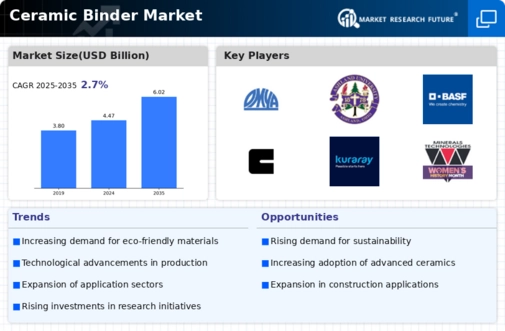Market Trends and Projections
The Global Ceramic Binder Market Industry is characterized by various trends and projections that indicate its future trajectory. The market is expected to grow from 4.47 USD Billion in 2024 to 6.02 USD Billion by 2035, suggesting a steady increase in demand. The compound annual growth rate of 2.74% from 2025 to 2035 highlights the potential for sustained growth driven by technological advancements, expanding applications, and increasing investments in infrastructure. These trends reflect the dynamic nature of the market and the ongoing evolution of ceramic binder applications across diverse industries.
Growing Demand for Advanced Ceramics
The Global Ceramic Binder Market Industry experiences a notable increase in demand for advanced ceramics, driven by their applications in aerospace, automotive, and electronics. As industries seek materials that offer superior performance, the utilization of ceramic binders becomes essential. For instance, advanced ceramics are increasingly used in manufacturing components that require high thermal stability and mechanical strength. This trend is expected to contribute to the market's growth, with projections indicating that the market could reach 4.47 USD Billion in 2024 and expand further to 6.02 USD Billion by 2035, reflecting a compound annual growth rate of 2.74% from 2025 to 2035.
Technological Innovations in Binder Materials
Technological advancements in binder materials significantly influence the Global Ceramic Binder Market Industry. Innovations such as the development of bio-based and environmentally friendly binders are gaining traction, aligning with global sustainability goals. These new materials not only enhance the performance of ceramic products but also reduce environmental impact. For example, the introduction of binders that improve the sintering process can lead to energy savings and lower production costs. As manufacturers adopt these innovative solutions, the market is likely to witness a shift towards more sustainable practices, further driving growth and expanding its applications across various sectors.
Rising Investment in Infrastructure Development
The Global Ceramic Binder Market Industry is positively impacted by increasing investments in infrastructure development across various regions. Governments and private sectors are focusing on building sustainable and resilient infrastructure, which often incorporates advanced ceramic materials for durability and longevity. For instance, the construction of roads, bridges, and buildings utilizes ceramic binders to enhance the performance of concrete and other materials. This trend is expected to sustain market growth, as infrastructure projects are anticipated to continue expanding, thereby increasing the demand for ceramic binders that meet stringent performance standards.
Expanding Applications in the Electronics Sector
The Global Ceramic Binder Market Industry benefits from the expanding applications of ceramic materials in the electronics sector. With the rise of electronic devices and components requiring high-performance materials, ceramic binders play a crucial role in the manufacturing of capacitors, insulators, and substrates. The demand for miniaturization and enhanced performance in electronics drives the need for advanced ceramic binders that can withstand high temperatures and provide electrical insulation. As the electronics industry continues to evolve, the market for ceramic binders is likely to grow, reflecting the increasing reliance on these materials for innovative electronic solutions.
Increased Focus on Sustainable Manufacturing Practices
The Global Ceramic Binder Market Industry is witnessing a shift towards sustainable manufacturing practices, driven by consumer demand for eco-friendly products. Manufacturers are increasingly adopting sustainable practices, including the use of renewable resources and waste reduction techniques in the production of ceramic binders. This focus on sustainability not only addresses environmental concerns but also enhances brand reputation and market competitiveness. As companies strive to meet regulatory requirements and consumer expectations, the adoption of sustainable ceramic binders is likely to gain momentum, contributing to the overall growth of the market.




















Leave a Comment